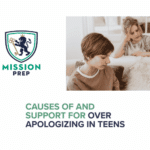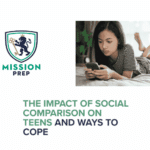People-Pleasing in Teens: Causes, Signs, and How to Support

Focusing on others’ needs can be a way to show kindness and empathy, especially when we are connecting with family and friends. However, too much of a good thing can become detrimental. When we consistently prioritize others above ourselves, important needs can be neglected. This is one of the main concerns with people-pleasing in teens.
Adolescents who engage in people-pleasing behavior risk doing damage to their own physical and mental health as a result. Think of the common saying, “You can’t pour from an empty cup.” In other words, teens need to have their own basic needs met if they want to be able to help others in a healthy way.
This article focuses on people-pleasing behavior and its influence on teen wellness and mental health. It does so by discussing the following topics.
- What teen people pleasing behavior is
- Causes of people-pleasing in adolescents
- Early intervention for approval-seeking
- Parental support for assertive teens

Teen People-Pleasing and Its Negative Effects
People-pleasing can present itself as part of a teen’s personality. In fact, one way that researchers measure people-pleasing tendencies is through a personality assessment called the “Langenfeld Inventory of Personality Priorities” (LIPP). The overarching concept captured in the LIPP is that people-pleasers have a strong desire to make others happy and gain acceptance.
Teen people-pleasing behavior involves prioritizing others’ needs, wants, and expectations above all else.1 Peer influence during adolescence is strong, and people-pleasing is one way your child might try to gain approval, or be “liked” by others.2 This can lead teens to do things that don’t necessarily align with their own morals and values.
There are several main reasons why teen people-pleasing is considered a maladaptive behavior. For instance, the negative effects of people-pleasing can include:3
- Not expressing their true feelings for fear of being judged by their peers
- Determining their worth based on how well they can please others
- Building fake and inauthentic relationships because they are afraid to express themselves freely
- Problems with setting boundaries and being able to assert themselves to get their needs met
Knowing that people-pleasing is a common problem for teens today, recognizing unhealthy behavior patterns remains a top priority.
Causes of People-Pleasing in Adolescents
It’s important to note that not all teens default to people-pleasing. So, what makes certain individuals more likely to develop this maladaptive coping strategy? There has been a lot of research focused on causes of people-pleasing in adolescents, and several key factors have consistently emerged. Let’s look at these in more detail.
Parenting Styles
One proposed model of parenting styles creates four categories: authoritative, authoritarian, permissive, and neglectful.3 Authoritative parenting is considered the most “healthy” style because it combines affection and structure in a child’s life. On the other hand, authoritarian and permissive parenting styles tend to promote people-pleasing behaviors. These styles of parenting fail to provide the emotional support that a child craves, and instead emphasize meeting consistent demands. With this style of parenting, when children don’t meet these demands, they often face criticism and punishment.3
School Experiences and Peer Relationships
Teens who experienced bullying may be more likely to turn to people-pleasing in order to feel accepted. Additionally, if a child has been excluded from a peer group due to negative judgements, they might try harder to please people so that they don’t face further social rejection. This goes hand-in-hand with a child’s response to peer pressure.3
Adolescents can also be negatively impacted by high expectations from teachers. In a stressful school environment which always pushes students to achieve the very best, a child can turn to people-pleasing behavior just to get by each day.3
Negative Childhood Experiences
Children who are consistently rejected or neglected by their caregivers can often turn to people-pleasing as a way of proving their worth. When a child is often left alone, with little-to-no physical or emotional support, they may start to believe that they aren’t “enough.” By doing what everyone else needs, wants, or expects, a child might gain positive attention, which then reinforces the behavior in the future. Similarly, children who have experienced any form of abuse may believe that the experience is their fault, and seek to make up for it by pleasing others.2
While each of these factors can play a role in people-pleasing behaviors, researchers are continuing to study causes of people-pleasing in adolescents, so other factors are being uncovered regularly.
Early Intervention for Approval-Seeking
Teen people-pleasing behavior is linked to a higher risk of developing depression and anxiety, as well as other mental health problems. Getting the right treatment to manage people-pleasing behavior can help prevent teens from experiencing worsening mental health. As we mentioned, people-pleasing can lead to negative outcomes later in life, so early intervention needs to address things like self-esteem, boundary-setting, assertiveness, and emotion regulation. Let’s explore some of these interventions further.
Self-Esteem Building in Teens
A common type of therapy used for self-esteem building in teens is cognitive behavioral therapy (CBT). The ultimate goal of CBT is to help teens acknowledge negative thinking patterns and change them.4 For instance, if a child thinks I need to get perfect grades for my parents to love me, the goal would be for them to recognize that this is not based in reality. Rather, by reframing this thought to something like It’s important to my parents that I get good grades, but that doesn’t define me as a person, can help the teen to develop confidence.
Additionally, the CBT therapist might prompt a teen to think about how that negative thought pattern has influenced their behavior in the past. Perhaps the child spent every moment of their free time studying, or avoided talking to their parents if they didn’t get a perfect score on a test. Part of CBT is understanding that by changing the negative thought pattern, a child is more likely to engage in healthier behaviors.
Therapy for Boundary Setting
Dialectical behavior therapy (DBT) is another form of therapy that can be helpful for adolescents. One of the modules, interpersonal effectiveness, teaches teens how to clearly communicate their needs and set healthy boundaries. Therapy for boundary setting can involve art, writing, and talk therapy, as ways of building up skills for healthy relationships.5
One specific DBT skill uses an acronym (DEAR MAN) to teach teens about communicating effectively:6
- Describe the situation using only facts
- Express your feelings by using “I” statements
- Assert what you want or need from the person
- Reinforce the benefits of the person meeting your needs
- Stay Mindful while communicating
- Appear confident by maintaining eye contact and speaking clearly
- Negotiate or compromise as needed, so you can both feel good about the solution
Participating in therapy for boundary setting can help teens who struggle with people-pleasing to regain control of their life and build better relationships.
Promoting Assertiveness in Teens
DBT and CBT also focus on promoting assertiveness in teens. As we mentioned earlier, by challenging negative thinking patterns, engaging in CBT allows teens to feel more confident in themselves. This allows them to assert themselves in social situations where they might otherwise not have.4 The DEAR MAN skill mentioned above in DBT also focuses on assertive communication in each step of the process.5,6
Emotion Regulation Strategies
Regulating difficult emotions can also help teens avoid people-pleasing because rather than just shutting down, they are encouraged to identify how their emotions are impacting their behaviors. One important emotion regulation strategy in DBT is called “opposite action.”6
Opposite action means that if the child is overwhelmed by a negative emotion, and their urge is to use a maladaptive behavior like people-pleasing, they will do the opposite instead. For instance, if a teen is being pressured by their friends to do something dangerous, they might want to go along with it because they are afraid of being abandoned. However, by acknowledging the feeling and acting opposite, they can avoid the dangerous behavior.
Parental Support for Assertive Teens
Parents play a key role in their child’s treatment. By modeling positive coping strategies for people-pleasing in the home, parents can encourage their child to act effectively during challenging situations. For example, practicing assertive communication and even modeling a conversation using the DBT DEAR MAN skill can help your child gain confidence in their ability to act effectively.
In addition, by providing an authoritative parenting style,3 combining love and affection with structure, parents can support independence in adolescents. Your teen will learn to do what they need to on their own, but also ask for help when it’s necessary. By taking part in all of these activities, you can provide the optimal parental support for assertive teens.

Mission Prep: Prioritizing Teen Wellness and Mental Health
At Mission Prep, we understand that adolescence is a stressful time in life. That’s why we want to provide all the resources you need to help your child get into the appropriate treatment program and prioritize their mental health. We offer CBT and DBT outpatient therapy, as well as residential mental health treatment for those who need extra support.
There is a lot of information out there and the number of treatment options can be daunting, so if you need assistance, feel free to call us at Mission Prep. Our team can listen to you and your child’s needs, and provide individualized recommendations for mental health treatment.
References
- Kuang, X., Li, H., Luo, W., Zhu, J., & Ren, F. (2025). The mental health implications of people‐pleasing: Psychometric properties and latent profiles of the Chinese People‐Pleasing Questionnaire. PsyCh Journal. https://doi.org/10.1002/pchj.70016
- Afifah, J. N., Maryama, H., Hayuningtyas, K., Mutamimah, U. S., Kamila, F. H., & Sugiharti, S. (2025). Effectiveness of revival assertiveness programs to increase assertiveness as an effort to address people pleasing behavior in High School Students. Jurnal Psikologi Tabularasa, 20(1). https://jurnal.unmer.ac.id/index.php/jpt/article/view/15147
- Georgescu, R. I., & Bodislav, D. A. (2025). The workplace dynamic of people-pleasing: Understanding its effects on productivity and well-being. Encyclopedia, 5(3), 95. https://doi.org/10.3390/encyclopedia5030095
- Mohamed, S. M. (2017). Effect of cognitive behavioral treatment program on anxiety and self-esteem among secondary school students. American Journal of Nursing Science, 6(3), 193-201. https://doi.org/10.11648/j.ajns.20170603.17
- Nunnery, R., Fauser, M., Hatchuel, E., & Jones, M. (2020). The use of dialectical behavioral therapy (DBT) techniques creatively in the treatment of perinatal mood and anxiety disorders. Journal of Counseling Research and Practice, 6(2), 3. https://doi.org/10.56702/UCKX8598/jcrp0602.3
- MacPherson, H. A., Cheavens, J. S., & Fristad, M. A. (2013). Dialectical behavior therapy for adolescents: theory, treatment adaptations, and empirical outcomes. Clinical Child and Family Psychology Review, 16(1), 59–80. https://doi.org/10.1007/s10567-012-0126-7



















